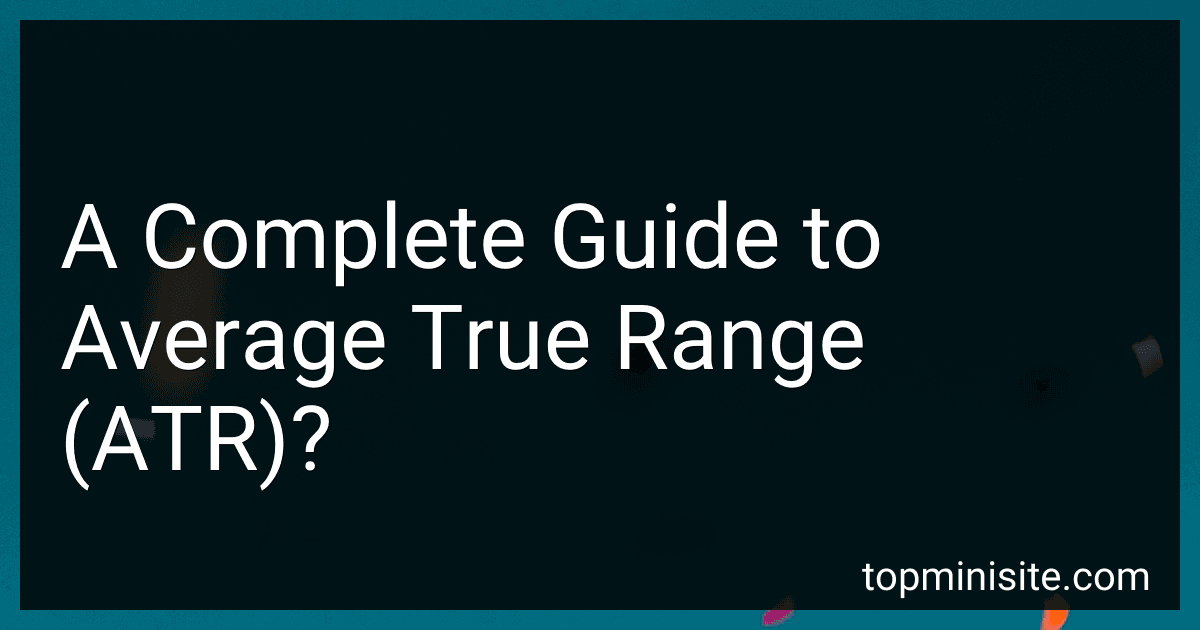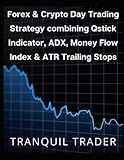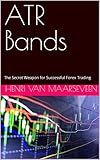Best ATR Indicators to Buy in December 2025
The Average True Range (ATR) is a popular technical analysis indicator that measures market volatility. It was developed by J. Welles Wilder Jr. and is widely used by traders and investors to assess the potential volatility of a security or market.
ATR is not a directional indicator like many other technical tools. Instead, it focuses on providing information about the volatility of price movements. It helps traders make informed decisions about their entry and exit points, stop-loss levels, and position sizes.
ATR is calculated by taking the true range of each period over a specified time frame, usually 14 periods, and calculating the average of these true ranges. The true range is defined as the greatest of the following:
- The difference between the current high and the current low.
- The difference between the previous close and the current high.
- The difference between the previous close and the current low.
The resulting value is an absolute number that represents the average range of price movement over the specified period. For example, if the 14-day ATR for a stock is $2, it suggests that the average daily price movement over the past 14 days is $2.
Traders use ATR in various ways. One common approach is to set stop-loss orders or trailing stops based on ATR. By using the ATR value, traders can adjust their stop levels in relation to market volatility. For example, a trader might set their stop level at two times the current ATR value, aiming to give the trade enough room to endure normal fluctuations.
Another use of ATR is to gauge a security's potential for trend reversals or breakouts. If the ATR value is relatively low, it indicates low volatility, suggesting that the market may be consolidating. On the contrary, a high ATR value suggests increased volatility and potentially significant price movements.
ATR can also be used for position sizing, particularly in risk management. By considering the ATR value, traders can adjust their position sizes accordingly, allowing them to limit potential losses or maximize potential gains depending on prevailing volatility conditions.
It is important to note that ATR is not suitable for comparing volatility levels across different securities, as it is relative to the price levels of each individual security.
In conclusion, the Average True Range (ATR) is a versatile tool used to measure market volatility. It helps traders determine optimal stop-loss levels, position sizes, and assess a security's potential for trend reversals or breakouts. By incorporating ATR into their analysis, traders can enhance their decision-making process and manage risk effectively.
How to calculate the average daily range using ATR?
To calculate the average daily range using Average True Range (ATR), follow these steps:
- Determine the period for which you want to calculate the average daily range. This could be a specific number of days or a rolling average over a certain period.
- Calculate the ATR for each day over the chosen period. ATR is usually calculated using a 14-day period, but you can adjust this as per your preference. The ATR is calculated by taking the true range for each day and averaging it over the chosen period. True range is calculated using the following formula: Calculate the difference between the high and low of the day (High - Low). Calculate the absolute difference between the high of the day and the previous day's close (|High - Previous Close|). Calculate the absolute difference between the low of the day and the previous day's close (|Low - Previous Close|). The true range is the largest of these three values. Repeat these calculations for each day over the chosen period and average the results to get the ATR.
- Once you have the ATR values for each day, sum them up and divide by the number of days to get the average daily range. This will give you an approximation of the average range within which the price moves on a daily basis over the chosen period.
Remember, ATR is a measure of volatility, so the average daily range calculated using ATR gives you an idea of the price fluctuations in a given period.
How can ATR be used in position sizing strategies?
ATR (Average True Range) can be used in position sizing strategies to determine the appropriate position size based on the volatility of a particular asset. Here's a step-by-step guide on how to use ATR in position sizing:
- Calculate the ATR: Calculate the Average True Range by taking the average of the true ranges over a specified number of periods. The true range is the greatest of the following three values: (a) the distance between the current high and low, (b) the distance between the previous close and the current high, or (c) the distance between the previous close and the current low.
- Define a risk percentage: Determine the maximum percentage of the total account balance that you are willing to risk on a single trade. This can vary depending on your risk tolerance and trading strategy.
- Determine the dollar risk per unit of ATR: Multiply the ATR value by the risk percentage to determine the dollar amount you are willing to risk per unit of ATR.
- Calculate the position size: Divide the dollar risk per unit of ATR by the value of each ATR unit. For example, if the dollar risk per unit of ATR is $100 and the ATR value is $10, the position size would be $100 / $10 = 10 shares/contracts/pips.
- Adjust for leverage: If you are trading with leverage, adjust the position size accordingly. For example, if you are using 2x leverage, you can double the position size calculated in the previous step.
By using ATR in position sizing, you can take into account the volatility of a security, which allows you to adjust your position size based on market conditions. This helps to limit risk and ensure that your positions are appropriately sized relative to the asset's price movements.
How does ATR help in identifying trend reversals?
ATR (Average True Range) is primarily used to measure volatility in a financial instrument. However, it can also be used to help identify trend reversals. Here's how ATR can assist in this process:
- Volatility measurement: ATR calculates the average range between a series of prices over a specified period. Higher ATR values indicate greater volatility, which can suggest potential trend reversals. Increasing ATR may indicate that market sentiment is changing, causing the trend to weaken or reverse.
- Breakouts and pullbacks: A significant increase in ATR after a prolonged period of low volatility may signal a potential trend reversal. For instance, if the ATR suddenly spikes, it could indicate that the current trend is losing strength, which may lead to a reversal or a breakout in the opposite direction.
- Contrarian trading: ATR can be used in combination with other technical indicators, such as moving averages. If the ATR is rising while prices are declining, it may indicate that selling pressure is increasing, potentially signaling a trend reversal. Similarly, if the ATR is falling while prices are rising, it may suggest that buying pressure is decreasing, potentially signaling a trend reversal.
- Confirming trend reversals: ATR can be used to confirm potential trend reversals that are identified by other indicators or chart patterns. For example, if a chart pattern like a head and shoulders pattern or double top/bottom is forming, an increase in ATR could confirm the potential reversal.
- Stop-loss placement: ATR can help traders determine appropriate stop-loss levels. In a trending market, placing the stop-loss beyond the average true range can provide protection against random volatility spikes that may indicate a trend reversal.
It's important to note that while ATR can provide valuable insights into potential trend reversals, it should not be solely relied upon. It is recommended to use it in conjunction with other technical analysis tools and indicators for a more comprehensive assessment.
How to incorporate ATR into a trading strategy?
Incorporating Average True Range (ATR) into a trading strategy can help traders make informed decisions based on market volatility. Here is how you can incorporate ATR into your trading strategy:
- Determine market volatility: ATR measures market volatility by calculating the average range (difference between high and low) of price movements over a specific period. Use the ATR indicator to assess market volatility levels.
- Set stop-loss levels: ATR can help determine optimal stop-loss levels for your trades. Multiply the ATR value by a multiple (e.g., 2 or 3) and set your stop-loss level at that distance from your entry point. This can help account for market fluctuations and potential trade reversals.
- Determine position size: ATR can also assist in determining your position size based on the volatility of the market. Higher ATR values indicate larger position sizes, while lower ATR values suggest reducing your position size.
- Identify potential profit targets: Use ATR to determine potential profit targets for your trades. Multiply the ATR value by a factor (e.g., 1 or 2) and add/subtract that amount to/from your entry point to set your profit targets. This can help you capture profits based on the market's volatility.
- Implement trailing stops: ATR can be used to set trailing stops, which can help protect your profits by adjusting the stop level as the market moves in your favor. Use a multiple of the ATR value and trail your stop loss at that distance below the current market price.
- Combine ATR with other indicators: While ATR is a useful indicator on its own, combining it with other technical indicators like moving averages, oscillators, or trendlines can enhance your trading strategy. Consider using a combination of ATR and other indicators to confirm trading signals.
Always remember to backtest any strategy incorporating ATR before using it in live trading. Additionally, adjust the parameters of ATR according to the time frame and market you are trading.
How does ATR differ from other volatility indicators?
ATR (Average True Range) is a popular volatility indicator that measures the average range between high and low prices over a given period. Unlike some other volatility indicators, ATR has several distinguishing characteristics:
- Objective Calculation: ATR is calculated based on actual price movements rather than using other indicators or formulas. It measures the true range of intra-day price movement, capturing gaps and price jumps effectively.
- Universal Applicability: ATR can be used across different financial markets and timeframes, making it versatile in analyzing the volatility of various assets like stocks, commodities, or currencies.
- Dynamic Nature: ATR adjusts its value depending on the price volatility of the underlying asset. It considers recent price movements, and as volatility increases or decreases, the ATR value adjusts accordingly.
- Standalone Indicator: ATR can be used on its own as a useful indicator, providing information about potential price volatility, the size of stop-loss levels, or the determination of profit targets. It is not reliant on other indicators to derive its value.
- Effective Risk Management: Traders often use ATR to manage risk by determining optimal stop-loss levels or position sizes based on the expected price volatility.
- Indicator of Market Conditions: ATR can indicate the overall market conditions. Higher ATR values could suggest more active and volatile markets, while lower values indicate quieter or less volatile periods.
Overall, ATR's unique calculation methodology and its ability to adapt to changing volatility make it a widely-used and effective tool for evaluating price movement.
What is the historical range of ATR readings for popular stocks?
The historical range of Average True Range (ATR) readings for popular stocks varies widely depending on factors such as the volatility and trading activity of each specific stock. ATR measures the average price range of a stock over a certain period, indicating the level of price volatility. Consequently, more volatile stocks tend to have higher ATR readings, while less volatile stocks have lower ATR readings.
To determine the historical range of ATR readings for a specific stock, you would need to analyze its price data over an extended period. The range can differ significantly between stocks, and it can also change over time due to various market conditions.
It is important to note that ATR readings are relative and should not be directly compared between different stocks. What might be considered a high ATR reading for one stock might be normal for another. Therefore, it is crucial to compare ATR readings within the context of the same stock and its historical price range to gain meaningful insights about its volatility.




